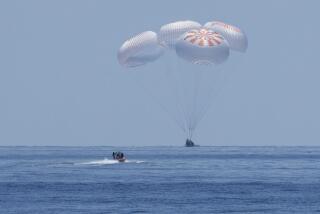Russians Plan to Drop Satellite Off Washington Coast : Space: Officials hope to attract U.S. investment with November rocket flight, splashdown and boat transfer to Seattle.
- Share via
MOSCOW — In a brash attempt to attract the attention and money of its U.S. counterparts, Russia’s military-industrial complex has come up with what seems like an unbeatable scheme to turn the heads of many in the American Northwest.
In November, officials intend to launch a three-stage rocket from northern Russia, officials announced Thursday. And in what a few years ago would have seemed like a Cold War doomsday scenario, two hours after dawn on Nov. 22, a satellite carried by the Proton booster is to splash down somewhere off the Washington coast, west of Seattle.
The formal occasion being marked is the 500th anniversary of Christopher Columbus’ voyage to the New World. But the real reason for the space shot is the Russian industry’s desperate need to find sources of foreign capital and cooperation to prolong its life.
“U.S. military industries are undergoing conversion at the rate of 4% and are already swooning from the effect,” Alexei N. Shulunov, president of the League of Defense Industries of Russia, who represents the defense plants involved in the space project, told a news conference. “We are trying to cope with 80% conversion, and obviously we need allies.”
In a recent trip to California, Shulunov found Americans turning a deaf ear to the Russian space industry’s problems; they expressed no eagerness to buy the latter-day products of the factories that put both Sputnik and Yuri Gagarin into orbit, ahead of their American competitors.
Such an attitude is dangerous, Shulunov said, noting: “In marked contrast to us, the Americans think only in terms of preserving existing jobs. They refuse to buy technologies we have to offer because that would mean more unemployment. Quite seriously, they think they’re still two heads above the world in this field, and need not worry at least until the end of this century. But the East is gaining on them and on us, and fast. Unless we form an alliance we are bound to lose this war.”
Hence the November space shot.
Becky Van Doren-Shulkin, acting science officer at the U.S. Embassy in Moscow, said she has already alerted the State Department to the Russians’ intentions, adding, “I’m telling them to take this dead seriously.” (Officials in Washington could not be reached for comment.)
Private sponsors of the “Europe-America Space Flight-500” said at the news conference that they have agreed to shell out the equivalent of $200 million to underwrite the project and to show American investors and firms what Russian rocket and aerospace industries are capable of.
Although the project has been drawn up with government backing, the launch would be the first from the Plesetsk cosmodrome to be financed by private firms.
“Not a kopeck of the taxpayer’s money (will go) into this launch,” boasted Gennady P. Alferenko, the chief coordinator of the project.
Documents handed out at the news conference said the unusual satellite will be recovered from international waters off the Pacific Coast by a Russian ship, then carried to Seattle in time for Thanksgiving, Nov. 26.
In Seattle, Bob Walsh and Associates, a sports marketing and production company, is making plans to have the Russian craft brought to the Port of Seattle, said project manager Bernard Russi. The two-ton satellite will be displayed at the port through Thanksgiving week; then it will eventually reside in the Museum of Flight in Seattle.
He scoffed at the notion that there will be any danger to Washingtonians, saying of the Russians: “It’s not as though they are targeting Washington state. They are targeting the Pacific Ocean.”
Times researcher Doug Conner in Seattle contributed to this report.
More to Read
Sign up for Essential California
The most important California stories and recommendations in your inbox every morning.
You may occasionally receive promotional content from the Los Angeles Times.













